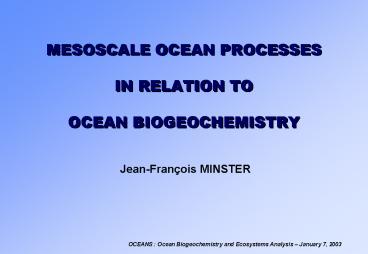MESOSCALE OCEAN PROCESSES IN RELATION TO OCEAN BIOGEOCHEMISTRY - PowerPoint PPT Presentation
1 / 41
Title: MESOSCALE OCEAN PROCESSES IN RELATION TO OCEAN BIOGEOCHEMISTRY
1
MESOSCALE OCEAN PROCESSES IN RELATION TO
OCEAN BIOGEOCHEMISTRY
- Jean-François MINSTER
2
Impact of mesoscale activity on
primary production in the North Atlantic (V.
Garçon et al.)
Three 3-D numerical experiments a) without
mesoscale activity, b) with mesoscale activity
c) with mesoscale activity and assimilation of
combined T/P and ERS1 altimetric data.
3
SeaWiFS Monthly data January 01 1998 January
31 1998 (G. Charrin et al.)
4
Mean sea level anomaly (SLA) data January 1998
(21/01-31/01)
5
(No Transcript)
6
Surface chlorophyll enrichment by Rossby waves
Modification of the isopycnals due to the passage
of waves ------gt more phytoplankton cells closer
to the surface (increase of the cells amount seen
by the captor and/or increase growth in the
enlightened (euphotic) zone)
1
Eddy pumping mechanism Upwelling of nutrients
due to rising of the nitracline associated with
wave ----gt effect on the phytoplankton growth
2
Advection of meridional gradients of
phytoplankton due to the geostrophic currents
associated with the baroclinic anomaly
3
7
1-Chlorophylllight and shift of isopycnals
8
2- Nutrient eddy pumping
9
CONCLUSION
Center of the South Atlantic ocean increase of
0.25 mg/m3 to 0.38 mg/m3 (0.13 mg/m3 ?
54) West part of the South Atlantic ocean
0.38 to 0.51 mg/m3 (0.13 ? 34 ) East part
of the South Atlantic ocean 0.39 to 0.59 mg/m3
(0.20 ? 49 )
Modification of the isopycnals due to the passage
of Rossby waves induced a shift of the DCM
(increase of the cells amount seen by the captor)
could explain the ocean color anomalies
But The other processes could also act 2-
Nutrient eddy pumping 3- Advection of meridional
gradients of phytoplankton
10
Phytoplankton and radiant heating in the
Equatorial Pacific
- variations of chlorophyll content
- modulation of the attenuation of solar radiation
- modification of stratification, heat budget, and
surface heat fluxes
- availability of ocean color data
- estimation of the contribution of phytoplankton
to radiant heating at intra-seasonal to
inter-annual time-scales
11
COASTAL OCEAN PHENOMENA
- Related to
- MESOSCALE OCEAN CURRENTS
- RIVER PLUMES
- NITRATE POLLUTION
- (F. Gohin, C. Labris, A Herbland)
12
Thanks to SeaWiFS the seasonal cycle of the
chlorophyll production in the Bay of Biscay is
better known
- High production can occur as soon as
mid-February outside of the river plumes in
stratified areas (haline stratification) - Peak in production occurs from mid-may to
mid-June in the river plumes
13
Late winter production in the Bay of
BiscayChlorophyll concentration (left) versus
Suspended Matters (right)
The bloom occurs in a clear and stratified area
River plumes are too turbid to sustain
significant production
14
In mid-spring the production is enhanced in the
river plumes
15
ZOOM in the Loire-Vilaine area
May 22
May 21
2001 May 23
May 24
in situ May 23
16
Maximum chlorophyll concentration at sea surface
has been observed at the end of May 2001
17
PEL 2000, AVRIL-MAI Surface
18
PEL 2000, AVRIL-MAI Surface
19
CONSTRAINING BIO-GEOCHEMICAL PARAMETERS
- Through assimilation
- of in situ
- and satellite data
- 1 Dimensional models
- Lagrangian models
20
(No Transcript)
21
(No Transcript)
22
(No Transcript)
23
(No Transcript)
24
June 1998 mean surface Chlorophyll, Top Model,
Bottom SeaWiFS (Gunson et al.)
25
Time series of chlorophyll following float 8
over the 270 days of the assimilation. Green
stars are the SeaWiFS observations (within 50 km
and 1 day of float) along with an error bar
(dotted line) of /- 0.1 mg Chl/m-3. Blue line
is the chlorophyll following the float and the
1-D model using the a priori parameters. Red
line is using parameters estimated from
observations taken only from float 8. Orange line
is using parameters estimated from observations
taken from float 8 and float 9.
26
An ensemble Kalman filter for the assimilation
of ocean colour data into a biochemical model of
the North Atlantic
Lars-Jørgen Natvik
Nansen Environmental and Remote Sensing Center
27
Motivation
- Data assimilation for linear models is well
understood, but the data assimilation problem for
nonlinear models is non-trivial. - Basin scale coupled physical-biochemical models
exist. - Data assimilation for ocean circulation models
well understood. - Data assimilation for ocean biochemical models
- Parameter estimation is well understood
- Less focus on state estimation
28
The photic zone biochemical model
Nitrate
Phytoplankton
Ammonium
Zooplankton
Bacteria
DON/DOC
PON/POC
Alkalinity
DIC
29
Model grid (140 x 130 resolution)
30
EnKF analysis at day 147
31
Conclusion - hindcast experiment
- The analyzed distribution of phytoplankton is in
better agreement with the observations than the
forecast distribution. - Analysis estimate is consistent with specified
error statistics. - The multivariate analysis also affects the
unobserved compartments. - The variance of all variables decrease
significantly during the analysis. - There is a considerable improvement from the
analysis even using 60 observation errors. - 60-80 ensemble members are required to have
reasonably well resolved covariances within the
defined radius of influence.
32
The scheme of operational oceanography
SATELLITE OBSERVATION
JASON
MERCATOR
IN SITU OBSERVATION
CORIOLIS
33
(No Transcript)
34
AVAILABILITY of weekly, real-time
Multiparameter products derived from
preoperationnal multisatellite sensors
35
(No Transcript)
36
(No Transcript)
37
(No Transcript)
38
Operational Algae Monitoring (G. Evensen et al.)
39
S P R I N G 2 0 0 2
40
Algae Bloom Type Discrimination
High pigments and low reflection flagellate
blooms Low pigments and high reflection
Coccolito- phophorid bloom (Emiliania huxley and
Skeletonema )
mg.l-1
Data courtesy Remote Sensing Group, PML, UK /
NASA SeaWiFS Project
41
CONCLUSION
- Well-established mesoscale phenomena with a net
average effects - Observing very high resolution features
deciphered in numerical models - Progress in assimilating biogeochemical
parameters in coupled models but still a lot to
be done - Using preoperational high-resolution systems for
ocean currents in support to biogeochemical
modelling and forecast































